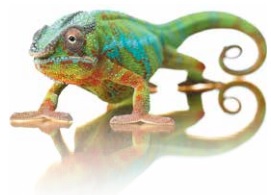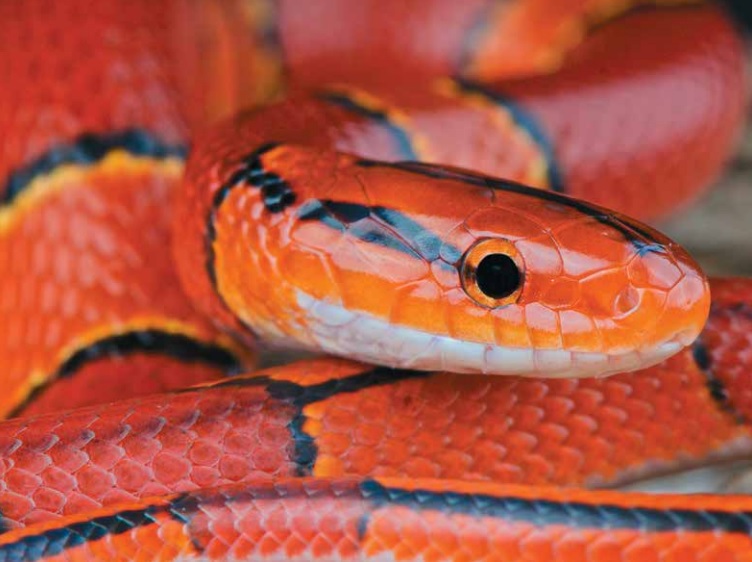Frogs, Snakes and Lizards are Exciting Options
John Mack //September 11, 2018//
Color is an immensely powerful driver in so many of our lives. Setting aside the stereotypical examples of stoplights and paint swatches, color has an ability to alter our mood and shape our mindset in ways that modern neuroscience is still learning to process.
According to Dr. Stephen Westland, chair of Color Science and Technology at University of Leeds, color acts directly on the hypothalamus, the portion of the brain “responsible for the secretion of a number of hormones which control many aspects of the body’s self-regulation, including temperature, sleep, hunger and circadian rhythms.”
What we see literally acts upon us in a real and tangible manner. Enter our pets.
Eye-catching Critters
Choosing a color for a pet is often a difficult question, right up there with the pet’s personality or the logistics of keeping a given pet within our homes. And within the realm of reptiles, color can be a retailer’s best ally in terms of providing customers with a unique pet experience. And, thanks to continued work in captive breeding programs, some of the most colorful reptiles around are becoming available to retailers for sale to customers.
Now, this is not to say that some of our oldest stand-bys don’t have much in the way of color variant. Colubrids such as corn snakes and king snakes, ball pythons, geckos and chameleons are all well-entrenched within pet stores across the world, and each has a number of colors and morphs available from most reptile breeders. As reptile breeders hone and refine their ability to track and mix genetic combinations, the potential for new color and pattern combination may well be effectively infinite.
With that said, though, certain animals relatively new to the pet trade are particularly notable for their coloration. Their vibrant colors and patterns can truly be both eye-catching to the casual customer and add an exotic touch that might attract a veteran reptile owner looking for something new to grace their enclosures.
Beautiful Options
One such avenue you may wish to examine is that of the Asian rat snake. These beautiful colubrids comprise a category stretching across China and Southeast Asia, coming in a variety of vibrant, rich colors. The most common of these—and likely the most diverse—are known as the beauty rat snake (Orthriophis taeniurus), which are arboreal creatures, preferring vertically-oriented enclosures with plenty of surfaces for climbing. While wild-caught specimens of beauty rat snake have gotten something of a reputation for a bad temper, captive-breeding has aided in providing these gorgeous animals with a much more suitable temperament for novice reptile owners. Color-wise, these creatures have an exotic pattern, featuring blacks and yellow-green, in patterned sequence. And, of course, thanks to captive-breeding, variations on this pattern have emerged, such as hypo and albino morphs.
Similarly, the bamboo rat snake (Oreocryptophis porphyraceus) has gained popularity. Known also as the “mountain racer,” these snakes are found in mountainous regions and tend to be much smaller than their arboreal kin. Bamboo rat snakes tend to come in bright reds and yellows, with dark black stripes running the lengths of their bodies. However, much as with their larger kin, the temperament for bamboo rat snakes have been much reduced in ferocity, making these beautiful creatures much more accessible for novice reptile keepers.
Turning to the opposite side of the world, rainbow boas (Epicrates cenchria) have begun to emerge as an alternative to the more common ball pythons and rosy boas, while providing a prismatic flair. Typically featuring a vibrant red or orange coloration, rainbow boas also have a series of microscopic ridges on their scales, which refract light and give the rainbow boa its colorful name. While several different types of rainbow boas have been wild-caught for years, the most common captive-bred rainbow boas tend to be the Brazilian and the Columbian varieties. I would recom – mend two major notes, however, for those interested in stocking rainbow boas. Firstly, young rainbow boas tend to be defensive, meaning additional handling may be necessary to ensure that the adult boa maintains a peace – able temperament. Further, these boas are typically nocturnal, which may be a turn-off for reptile owners looking for a more active, diurnal pet.
Knowledge is Key
When considering any of these animals, the most important factor as a pet retailer is for you to know your market. Is there a substantial reptile-owning community surrounding your store? Are your customers typically new reptile owners, or are they veterans? Do you have some “regulars” who come by for supplies on a weekly or biweekly basis, looking for something new? If your store does not have an already-established base of reptile enthusiasts, you may find that jumping immediately to a more exotic animal will only result in that creature becoming a ‘store mascot’ instead of someone’s pet.
Under ideal circumstances, some of these colorful animals should make your store into the place to be. By stocking these animals—and, with them, teaching your staff to both care for them and to convey that information to would-be customers—you establish yourself among the local reptile experts.
With that information, you can rise above the rank-and-file, becoming more than just another basic store. If you’re stocking rainbow boas, ensure that your staff is used to handling those creatures throughout the workday, showing them off to your customers and engaging both the snake and their potential owners. Doing so provides your customers a zoo-like experience that they simply can’t get at their local big box store.
With a little dash of color in your store, you’re sure to increase engagement with your customers and, with it, your overall sales! Try something new!



















